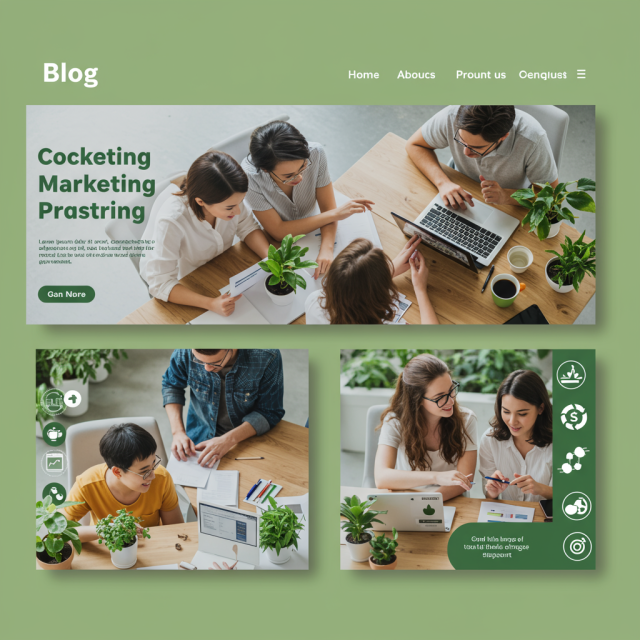In today’s market, consumers increasingly seek brands that align with their environmental values. Eco-friendly inbound marketing blends sustainability principles with customer-first tactics to attract, engage, and delight audiences. By placing your brand’s green initiatives at the heart of your inbound strategy, you can build trust, foster loyalty, and drive conversions. In this post, we explore actionable steps to craft inbound campaigns that resonate with eco-conscious buyers. You’ll learn how to map sustainability messages to each stage of the customer journey, select the right content formats, and measure impact without greenwashing. Whether you’re a small startup or a large enterprise, these best practices will help you stand out in a crowded space. Let’s dive into eco-friendly inbound marketing that delivers real results while protecting our planet.
Why Sustainability Matters in Inbound Marketing

Sustainability has evolved from a niche concern into a mainstream purchase driver. According to recent studies, over 70% of consumers are more likely to support brands with transparent environmental practices. Integrating sustainability into your inbound approach not only meets customer expectations but also differentiates your brand in competitive markets. By showcasing commitments such as carbon-neutral operations, ethical sourcing, or zero-waste packaging, you communicate authenticity and build authority. Inbound marketing thrives on value-driven storytelling, and eco-friendly narratives are inherently compelling. They inspire trust, generate social proof, and encourage word-of-mouth referrals. Moreover, search engines increasingly reward content that addresses trending topics like climate change and the circular economy. Therefore, sustainability isn’t just a moral choice—it’s a strategic advantage you can leverage to power your inbound growth cycle. Learn more about Sustainable Inbound Marketing.
Aligning Brand Values with Inbound Touchpoints
To create a coherent, eco-friendly inbound strategy, start by auditing your brand values and sustainability goals. Document your environmental initiatives, certifications, and roadmap for continuous improvement. Next, map these elements to each stage of the inbound funnel—Attract, Engage, and Delight. At the Attract stage, optimize educational blog posts around key eco topics and seed them via social media. During Engage, offer gated resources, such as sustainability whitepapers or webinars hosted by subject-matter experts. Finally, Delight customers with eco-focused loyalty programs, behind-the-scenes factory tours, or exclusive volunteer events. By weaving your green story across touchpoints, you ensure consistency and deepen emotional connections. Don’t forget to train your sales and support teams to speak authentically about your sustainability commitments. This holistic alignment fosters brand advocacy and positions you as a trusted partner in your customers’ sustainability journeys.
Keyword Research for Sustainable Audiences
Effective eco-friendly inbound marketing begins with targeted keyword research. Identify search terms that eco-conscious consumers use when seeking information about sustainable living, green products, or ethical business practices. Tools like Google Keyword Planner, Ahrefs, and SEMrush can surface high-volume, low-competition phrases such as “zero-waste packaging ideas”, “carbon footprint calculator”, or “sustainable fashion tips”. Don’t overlook long-tail queries that signal purchase intent, such as “best biodegradable cleaning products online”. Group keywords thematically into clusters—e.g., Packaging, Energy Efficiency, Ethical Sourcing—and assign each cluster to relevant blog posts or resource pages. Use keyword – intent mapping to tailor content to awareness, consideration, or decision stages. Incorporate primary and secondary keywords naturally in headings, meta descriptions, image alt text, and body copy. This targeted approach helps you rank higher in organic search results and ensures the right audience discovers your eco-friendly content.
Crafting High-Value Green Content Formats
Once you’ve identified your keyword clusters, choose content formats that resonate with sustainability-minded audiences. Long-form blog articles provide in-depth guides on topics like circular economy principles or how to host a zero-waste event. Interactive tools—calculators for carbon emissions or quizzes on sustainable habits—drive engagement and data collection. E-books and whitepapers offer downloadable resources for mid-funnel nurturing, while case studies showcase real-world success stories. Video content, including factory walkthroughs or eco expert interviews, engages visual learners and boosts social shares. Infographics help simplify complex environmental data into easily digestible visuals. Webinars and virtual workshops establish thought leadership and enable live Q&A. For post-purchase delight, consider customer-generated content campaigns highlighting photos of products in use. By diversifying your content mix, you cater to varied preferences and bolster lead generation across the inbound funnel.
SEO Best Practices for Eco-Friendly Campaigns
Optimizing your sustainable content for search engines is critical to expand reach. Start with on-page SEO: include target keywords in titles, subheadings, and meta descriptions while maintaining readability. Optimize images with descriptive file names and alt text that reflect eco-focused terms. Implement internal linking to guide readers from introductory posts to deeper resources or product pages. Use structured data markup, such as FAQ schema, to improve visibility in rich search results. Improve site speed and mobile responsiveness, as green-minded audiences often browse on the go. Build backlinks from reputable environmental organizations, NGOs, or eco blogs by contributing guest articles or research. Regularly update evergreen content with the latest data to maintain rankings. Monitor performance using Google Analytics and Search Console, then refine your SEO plan based on high-performing keywords and pages. This continuous optimization ensures your eco-friendly inbound content attracts maximum organic traffic.
Leveraging Social Media and Communities
Social platforms are powerful channels to amplify your eco-friendly inbound efforts. Identify networks where sustainability conversations thrive—LinkedIn for B2B collaborations, Instagram for visual storytelling, and Facebook groups for community engagement. Share bite-sized tips, behind-the-scenes videos of your green processes, and user-generated content from customers demonstrating sustainable product usage. Host live Q&A sessions with eco experts or brand ambassadors to deepen connections. Collaborate with influencers and micro-influencers known for environmental advocacy to tap into niche audiences. Encourage social sharing of your interactive tools and infographics by adding social share buttons and clear calls-to-action. Engage in relevant online communities by answering questions, providing insights, and linking to your high-value resources. Track engagement metrics such as shares, comments, and click-through rates to identify top-performing content and refine your social media strategy over time.
Email Nurturing for Sustainable Advocacy

Email remains one of the most effective channels for nurturing eco-conscious leads. Segment your subscribers based on interests—energy efficiency, plastic reduction, or eco-friendly fashion—and tailor email sequences accordingly. For new leads, send a welcome series that introduces your brand’s sustainability mission and offers a free guide or calculator. Mid-funnel sequences might share case studies, product comparisons, or invitations to webinars on green best practices. For customers, create loyalty campaigns that reward repeat purchases with discounts on eco-friendly merchandise or invites to volunteer events. Use personalization tokens to address subscribers by name and reference their stated green interests. Incorporate visually appealing banners, concise copy, and clear calls-to-action that drive clicks to your content or product pages. Monitor open rates, click-through rates, and conversion metrics to optimize subject lines, send times, and content layout. Consistent, value-packed email nurturing cultivates long-term advocacy among sustainability-minded audiences.
Measuring Impact and Optimizing Performance
To ensure your eco-friendly inbound marketing efforts deliver ROI, establish clear KPIs aligned with both marketing and sustainability goals. Key metrics include organic traffic growth, lead-to-customer conversion rate, email engagement, social shares, and backlink acquisition. Additionally, track sustainability-specific outcomes—such as reductions in paper use, donations to environmental causes, or carbon-offset purchases tied to campaigns. Use marketing automation platforms and CRM integrations to attribute conversions to specific content pieces or channels. Conduct A/B tests on headlines, CTAs, and email subject lines to refine messaging. Collect qualitative feedback through surveys to understand how your audience perceives your green initiatives. Review analytics data monthly and quarterly to identify trends and areas for improvement. By combining traditional marketing metrics with sustainability impact measures, you can optimize your inbound strategy to drive both growth and meaningful environmental progress.
Conclusion
Eco-friendly inbound marketing offers a powerful framework to connect with sustainability-minded consumers while advancing your environmental commitments. By aligning your brand values with each stage of the inbound funnel, conducting targeted keyword research, and producing diverse, high-value content, you can attract and engage audiences in authentic ways. Optimize for SEO, leverage social media communities, nurture leads via personalized email sequences, and rigorously measure both marketing and sustainability outcomes. As consumer demand for responsible businesses grows, your ability to deliver genuine green value will set you apart. Start implementing these strategies today to build stronger customer relationships, boost conversions, and contribute to a healthier planet through thoughtful, eco-friendly inbound marketing.




